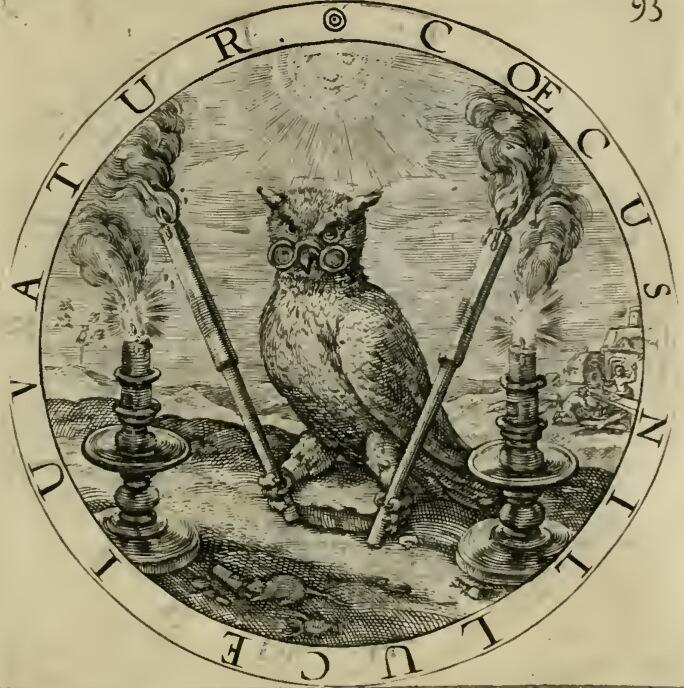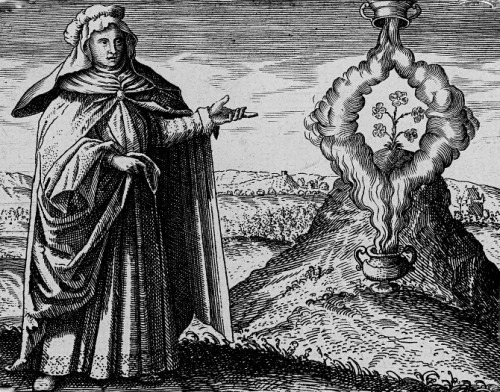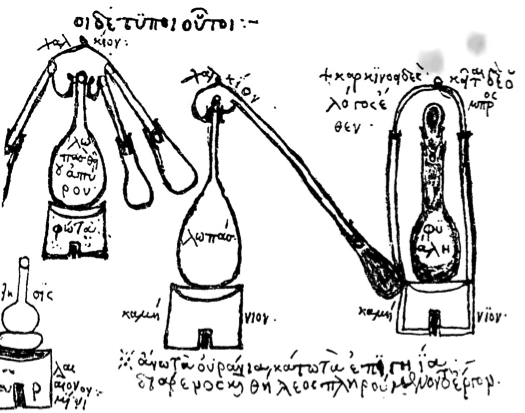The Early Alchemists of the West

Alchemy Rising
I found it strange that in my research I found no short, simple introduction to the first known alchemists in the Western world. A future article in progress, “Alchemy and the Birth of Modern Science,” will address the rise of operative alchemy in context of the beginnings of ancient science and technology.
What is interesting about the first recorded alchemists of the West is that they are a mix of operative and speculative alchemists, and often both in a single person. These remarkable men and women are shrouded in mystery and legend, but we honor them, nonetheless, and remember their contributions to the Royal Art.
Plato’s Timaeus
The ancient Greek philosopher Plato (428 – 348 BCE) was the pupil of Socrates and the tutor of Alexander the Great. Plato was not, himself, an alchemist. However, Plato’s cosmology was essential to the alchemical worldview after the Roman statesman Cicero’s (106 – 43 BCE) translation of his works into Classical Latin. His fame grew even wider from the fourth century CE when the otherwise obscure Calcidius translated the first part of his dialogue, the Timaeus, from the Greek into Late Latin.
The Timaeus describes the cosmic opposites as the eternal and the physical. The cosmos, shaped as a dodecahedron (the prima materia), was a mixture of four geometric elements, tetrahedron (fire), octahedron (air), icosahedron (water), and cube (earth). It is the creation of a divine craftsman, a demiurge or god. The demiurge is good and created the world to be both good and evil. The world is a living being with a soul, the anima mundi, and human beings were created with a soul and intelligence placed into a body.
Hundreds of lesser-known European magicians and alchemists in the Middle Ages often used a famous name as a pseudonym in order to promote their works. Examples include Moses, Solomon, Aristotle, Hermes Trismegistus, Geber and Raymond Lull.[1] It is customary to refer to such authors as Pseudo-[name] so as to credit individuals only for their own works. An honest and organized practice will aid us in our quest for the truth. Plato was one of the most used pseudonyms due to the centrality of his philosophy as the basis of alchemy.

Ostanes the Magus
The origin of the earliest name associated with alchemy in the Western world is as mysterious as the origin of alchemy, itself. The names of three ancient Persian Magi were used as pseudonyms by later Greek and Latin Hellenic pseudo-anonymous authors. Hystaspes was the patron of Zoroaster, the founder of the Persian Zoroastrian religion and first Magus.
Ostanes was the third such name, and according to fourth century Platonic philosopher Hermodorus, he was the first disciple of Zoroaster, but Hermodorus wrongly dates Zoroaster as 5,000 years before the fall of Troy. The Trojan War described by Homer in the Iliad occurred in the twelfth century BCE and Zoroaster lived either in the eleventh or seventh-sixth centuries BCE, which indicates that Hermodorus had very faulty information in regards the first Magi.
The Roman commander, naturalist, natural philosopher and author Pliny the Elder (23 – 79 CE), was an acquaintance of the emperor Vespasian and the uncle of Pliny the Younger, an imperial magistrate for the empire and renowned author and orator. Pliny the Elder wrote Naturalis Historia, or Natural History, which became the standard prototype for encyclopedias for centuries into the future.
Pliny wrote in his Natural History that Zoroaster was the inventor of magic and Ostanes was the first extant author to write about it. Thus, naturally many later pseudepigraphic works of magic were written under his name. Pliny suggested the impossible scenario that Ostanes accompanied both the fifth century BCE Persian king Xerxes the Great and fourth century BCE Macedonian king Alexander the Great, introducing magic to the Greeks.
Pliny asserted that the famous Greek philosophers like Pythagoras, Plato and Democritus sought out the instruction of magic in the East and returned to Greece to teach it. Pliny linked the Magus Ostanes with divination and necromancy. In time he was associated with alchemy, astrology, talismans, and the magical properties of minerals and vegetables. By the fourth century CE Ostanes was recognized as a foremost authority in magic and alchemy.
Bolus of Mendes
(Pseudo-Democritus)
The earliest known historical alchemist was Bolus of Mendes or Pseudo-Democritus, a first century CE Greek alchemist concerned with both the “Physical and Mystical” transmutation of lead or iron into silver and gold for the alleviation of poverty. He is best known for his work, Physika kai Mystika, or “Physical and Mystical Matters,” wherein he describes the color changes material goes through during the four stages of transmutation: blackening, whitening, yellowing and reddening. Bolus wrote four extant books[2] and was quoted by Zosimos, by the 300 CE Papyrus Graecus Holmiensis (Stockholm Papyrus) and by Byzantine alchemists.
The alchemical recipes of Pseudo-Democritus are also found in two other magical alchemical documents. The first is the Judaeo-Gnostic papyrus W of the third century CE Greek magical papyri of Leyden, which contains some of the oldest extant alchemical recipes. The second is the Eighth Book of Moses, or The Key of Moses, a fourth century magical grimoire out of Graeco-Roman Egypt that describes alchemical recipes along with magical spells and incantations.
This Bolus of Mendes is not to be confused with the Egyptian who lived in the Nile delta around the third century BCE, and wrote under the name Democritus. This Bolus seems to have been a Neo-Pythagorean philosopher, physician and astronomer mentioned by the tenth century Byzantine encyclopedia, the Suda, which also mentions another Bolus who followed Democritus and wrote on medicine.

Agathodaemon
In Greek mythology an agathodaemon, “noble spirit,” was a spirit of the vineyards and fields of grain. The spirit was a personal companion or family spirit of good fortune.
Agathodaemon (c. 30 CE) lived in Egypt under the Roman Empire. All else that is known about him are his sayings as quoted by the Anepigraphos (“Untitled” fragment of Hermetica) and a few other medieval alchemical works. These describe physical elements and his experiments fabricating silver (“the moon”) and fusing a toxic mineral (probably realgar) with natron to create amphoteric oxide, known today as arsenic trioxide, and dissolving the mixture in water to form a solution he called ‘fiery poison.’ This appellation was fitting, as arsenic was subsequently a popular poison used to kill weeds, pests, vermin and of course, people.
Agathodaemon was the first to mention a stone in alchemical transmutation.

Mary the Jewess
Along with the first century Bolus and Agathodaemon, we know of two early famous women alchemists: Mary the Jewess and Cleopatra the alchemist. Mary the Jewess (Latin Maria Hebraea), also known as Maria the Prophetess (Maria Prophetissa), lived in Egypt and Canaan probably during the first century CE and was referenced by Zosimos as an early inventor who performed experiments.[3] Mary was known to the medieval Byzantines through the eighth century George Synchellus and the Arabs via the chapter on alchemy in the Kitāb al-Fihrist of Ibn al-Nadim.
Although the claims have been disputed, Mary has been said to have been a talented inventor as well as the discoverer of hydrochloric acid. Zosimos gives her credit in the invention of the bain-marie, “Mary’s bath,” a double boiler that heats its contents slowly, constrains the temperature of one vessel to the boiling point of a liquid in its other vessel, and maintains a gentle heat to keep ingredients warm.
Mary is also said to have had contributed to the development of the tribikos, a copper or brass alembic with three arms used in distillation; and the kerotakis, used to heat ingredients and collect the vapors in what would become known as a “hermetically sealed” or air-tight chamber, in emulation of the formation of gold within the earth.
Nothing Mary wrote survives, but certain mystical phrases and descriptions of basic alchemical operations are attributed to her, such as those in The Dialogue of Mary the Jewess and Aros. She is said to have spoken of acids and acid salt, alchemical whitening and yellowing, and the transmutation of vegetable matter into gold. She is supposed to have taught speculative alchemy as the union of opposites, male and female, to produce the goal of the alchemist.
The Axiom of Maria is an alchemical adage respected by the alchemist Dr. Carl Gustav Jung: “One becomes two, two becomes three, and out of the third comes the One as the fourth.”

Cleopatra the Alchemist
Cleopatra the Alchemist was one of many anonymous alchemists who used a pseudonym. She was a successful Greek philosopher, alchemist, inventor and author who lived in third century Egypt. She was at times confused with Cleopatra VII the Queen of Egypt, who had affairs with Julius Caesar and Marc Antony in the first century BCE, and she was also mistaken for Cleopatra the Physician, her contemporary.

Cleopatra is famed for inventing an early alembic, an alchemical still used for distillation, which she presented in her works. She used weights and measures in her alchemical experiments and wrote a manuscript on the subject called On Weights and Measures. Her other book was the Chrysopoeia of Cleopatra, which described the transmutation of base material into gold, associated with the Philosopher’s Stone, the ultimate goal of the Great Work. Cleopatra is highly lauded in the tenth century Arabic encyclopedia Kitāb al-Fihrist.

Zosimos of Panopolis
Zosimos of Panopolis, the Hermetic philosopher and famous author of alchemical works, lived in Alexandria, Egypt in the early fourth century. The Mafatih al-rahmah wa-masabih al-hikmah, or Keys of Mercy and Secrets of Wisdom by the eleventh century Persian Mu’ayyad al-Din Abu Isma‘il al-Husayn ibn Ali al-Tughra’i contains, in the first part, a survey of alchemical doctrine and passages from Arabic alchemists. In the second part it presents an Arabic translation of original Greek writings of Zosimos. A copy of the text is kept in the Library of Congress.
Zosimos’ chemical knowledge is largely dismissed as proto-science today, but he did describe that vapors rise during distillation because motion is caused by heat. He recognized that distillation is a form of purification. Modern chemists note that alchemists correctly regarded the physical properties of substances to be determined by their chemical composition and classified compounds by color, odor and taste.[4]

Zosimos is considered a pivotal character in the history of alchemy as the first writer on alchemy on the West, in his Chrysopoeia (“gold-making” or transmutation into gold). Some of his sources were Gnostic or Hermetic and he often quoted Mary the Jewess, whose works are otherwise largely lost. Zosimos produced illustrations of alchemical apparatuses that he had learned of or seen on his travels and likely used in his own laboratory.
Other alchemical texts include The Book of Pictures, Book of the Keys of the Work, On the Evaporation of the Divine Water that Fixes Mercury, The Sulfurs, and Treatise on Instruments and Furnaces. Zosimos’ spiritual alchemical visions are recorded in his Visions of Zosimos.

Other early Egyptian alchemists include Moses of Alexandria in the first or second century CE, a Jewish author who wrote about mercury, copper and arsenic, as well as the process of distillation and the transmutation of metal into gold. According to Zosimos’ letters to his sister Theosebeia, presumably an alchemist, herself, Paphnutia the Virgin was an Egyptian alchemist who lived in the early fourth century.
Olympiodorus (c. 380 – 425 CE) from Thebes was a historian of the Roman Empire known to Zosimos, who may have been a poet or an alchemist. The seventh century Byzantine Stephanus of Alexandria was a lecturer in the court of the Byzantine emperor Heraclius. Stephen was known as the Universal Philosopher and he taught subjects such as Plato, Aristotle, Mathematics, Astronomy and Alchemy.

Hermes Trismegistus
From ancient Egypt to Classical times the Egyptian god Thoth, associated with the Greek god Hermes and the Roman Mercury, evolved to encompass a vast number of attributes, but the consistent function of this deity was the dispensing of wisdom. It was natural, then, that the European Renaissance philosophers that studied the writings attributed to Hermes Trismegistus of Alexandria should have imagined the legendary author to be the divine person of ancient Egyptian mythology, an historical individual contemporaneous possibly even with Moses.
Hermes Trismegistus or “Hermes the Thrice Great” of Alexandria, Egypt was thrice great as legislator, priest, and philosopher. He taught alchemy and magic, as well as gnostic and Neo-Platonic concepts. Egyptian-Greek teachings with Hebrew and Christian influences, attributed to Hermes Trismegistus, were written in the second and third centuries of the Christian Era.
This Alexandrian syncretic philosophy was transmitted through a collection of dialogues called the Hermetica. This body of work was intended as knowledge that led to the union of man (gender neutral Homo sapiens) and God.[5] The most famous of these works are the Poimandres (the “Shepherd of Man”) and the Emerald Tablet. The Emerald Tablet first appeared in Arabic around the seventh century and was translated to Latin in the twelfth century.

The interest in Greek Hermetica and Neoplatonic texts was first revived in Europe during the Italian Renaissance. Under the patronage of the Florentine ruler Cosimo de’ Medici (1389 – 1464), Marcilio Ficino was installed as head of the resurrected Plato’s Academy at Florence, and translated the Hellenistic Hermetic documents into Latin as the Corpus Hermeticum.
Since that time, Christian scholars believed Hermes Trismegistus had prophesied the coming of Jesus Christ, due to indirect references to Trinitarian doctrine. It was not until 1614 that Isaac Casaubon showed that the writings probably emerged in the early Christian Era, implying the author’s familiarity with Christian doctrine.
Hermes Trismegistus was considered to be the first alchemist, and as such was highly regarded by Ficino’s contemporaries and later, those who supported the proto-scientific Rosicrucian movement. His reputation suffered only at the hands of Christians who regarded all such things as mathematics, science, alchemy and magic in general as occult topics born of Satan the mythological Devil, the supernatural enemy of the Biblical Lord Creator God, Yaweh.
Hermes Trismegistus even impressed the first speculative Freemasons, who included him as a founder of Freemasonry in all the early documents from the Old Charges on. Philosophically, Hermes Trismegistus remains with us today through his teaching, “as above, so below,” as taught in the alchemical treatise, The Emerald Tablet. A copy of Isaac Newton’s translation of the poem is preserved at King’s College Library, Cambridge University.
Isaac Newton’s Translation of
The Emerald Tablet c. 1680.[6]
1) Tis true without lying, certain & most true.
2) That wch is below is like that wch is above & that wch is above is like yt wch is below to do ye miracles of one only thing.
3) And as all things have been & arose from one by ye mediation of one: so all things have their birth from this one thing by adaptation.
4) The Sun is its father, the moon its mother,
5) the wind hath carried it in its belly, the earth its nourse.
6) The father of all perfection in ye whole world is here.
7) Its force or power is entire if it be converted into earth.
7a) Seperate thou ye earth from ye fire, ye subtile from the gross sweetly wth great indoustry.
8) It ascends from ye earth to ye heaven & again it desends to ye earth and receives ye force of things superior & inferior.
9) By this means you shall have ye glory of ye whole world & thereby all obscurity shall fly from you.
10) Its force is above all force. ffor it vanquishes every subtile thing & penetrates every solid thing.
11a) So was ye world created.
12) From this are & do come admirable adaptaions whereof ye means (or process) is here in this.
13) Hence I am called Hermes Trismegist, having the three parts of ye philosophy of ye whole world.
14) That wch I have said of ye operation of ye Sun is accomplished & ended.
This work is prominent in the literature of alchemy and the figure of Thoth-Hermes-Mercury historically forms a central theme in the Western tradition of the Royal Art.
BIBLIOGRAPHY
